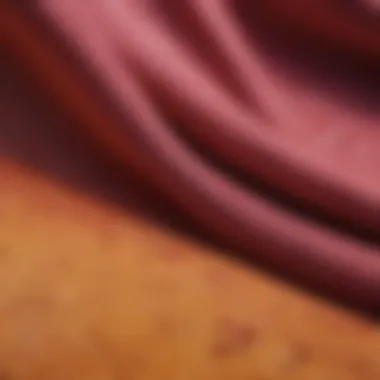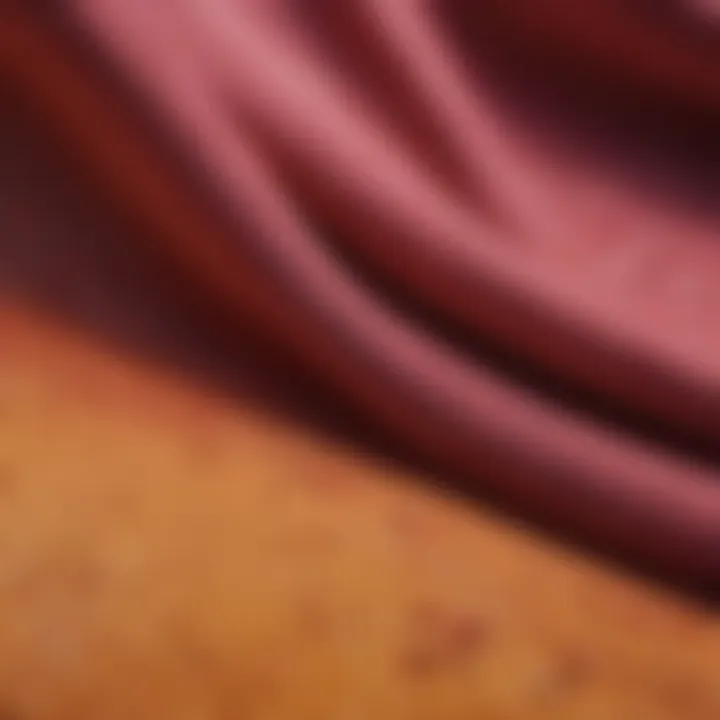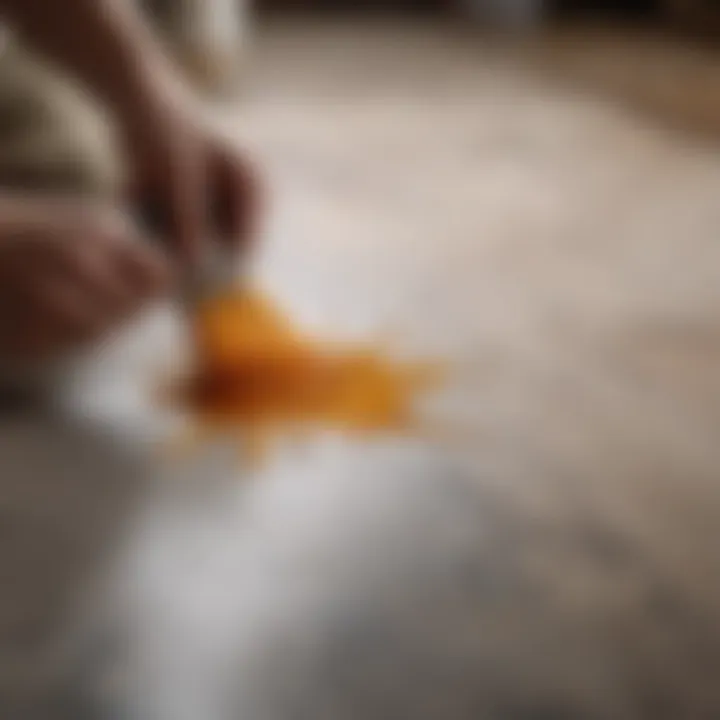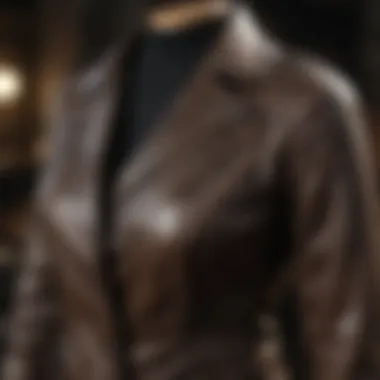Effective Strategies for Removing Paint Stains from Clothing


Intro
Paint stains on clothing can be a source of frustration for many. Whether you're an artist, a DIY enthusiast, or simply someone who enjoys a creative project at home, your clothes can often bear the brunt of paint spills and splatters. Understanding how to effectively remove these stains is essential for maintaining the integrity of your garments. This guide unpacks various strategies tailored specifically for different types of paint, addressing both water-based and oil-based paints. We will also discuss the necessary tools and products, as well as preventive measures to keep your clothing looking pristine.
Understanding Paint Types
Before diving into stain removal techniques, it is critical to identify the type of paint involved.
- Water-based paints, like acrylics, are easy to clean when treated promptly.
- Oil-based paints, meanwhile, require specific solvents for effective removal due to their more tenacious nature. Knowing the difference can save time and effort during the cleaning process.
Tools and Materials Needed
To successfully remove paint stains, gather the following items:
- Rubbing alcohol or solvent (for oil-based paints)
- Dish soap (for water-based stains)
- Paper towels or cloths
- A soft-bristled brush
- Cold water
- Stain removers tailored for fabrics
- An old toothbrush (for intricate details)
Having these materials on hand ensures you can act swiftly, increasing the likelihood of complete stain removal.
Step-by-Step Process for Water-Based Paints
- Act Quickly: The sooner a stain is addressed, the better.
- Remove Excess Paint: Use a spatula or the edge of a credit card to gently lift off any excess paint. Be careful not to smudge the paint further.
- Rinse with Cold Water: Hold the fabric under running cold water, allowing the water to flow through the back of the stain to push the paint out.
- Apply Dish Soap: Directly apply dish soap to the stain and work it gently with your fingers or a soft-bristled brush.
- Rinse Again: Rinse the area thoroughly with cold water.
- Launder: Finally, launder the clothing as per the care label instructions. Check for any remaining stains before drying.
Step-by-Step Process for Oil-Based Paints
- Time is of the Essence: Similar to water-based paint, act quickly.
- Scrape Off Excess Paint: Use a spatula or similar tool to gently lift away the excess paint, being careful to not embed it deeper into the fabric.
- Apply Rubbing Alcohol or Solvent: Dampen a cloth or paper towel with rubbing alcohol and blot the stained area. It is essential to not rub, as this can spread the stain.
- Blot and Repeat: Continue to blot with fresh cloths until no more paint is transferring. It may take several applications.
- Wash as Usual: Once the stain is removed, launder as per care label instructions.
"Prompt action can make all the difference in paint stain removal."
Preventive Measures
To reduce the likelihood of future paint stains:
- Wear old clothes during painting sessions.
- Utilize drop cloths or old sheets to protect surfaces and clothing.
- Consider using aprons or smocks for extra protection.
- Always keep stain removal tools handy for quick action.
By following these strategies, homeowners and creative individuals can ensure their clothing remains in great condition, free from the woes of paint stains.
Understanding Paint Stains
To effectively tackle paint stains on clothing, it is essential to first understand their nature. Paint stains can vary significantly depending on the type of paint involved. Knowing the properties of different paints can inform the best removal strategies. This knowledge is critical because incorrect approaches may spread stains or damage fabrics. Therefore, comprehending paint stains is not just beneficial but necessary for successful treatment.
Types of Paints
Water-Based Paints
Water-based paints are commonly used for indoor applications, such as wall painting. They usually have a thinner consistency and are easier to clean with just soap and water. Their key characteristic is the use of water as the primary solvent, making them less harmful to the environment. People often find them favorable because they emit fewer odors and dry quickly. However, one disadvantage is that they can be more susceptible to running or smudging if not handled correctly. In terms of stain removal, water-based paint can be relatively easier to treat compared to other types.
Oil-Based Paints
Oil-based paints, on the other hand, are known for their durability and rich color. They generally provide a glossy finish that many find visually appealing. Their key characteristic is the oil solvent, which makes them more resistant to moisture and fading. Because of their strong adherence capabilities, oil-based stains can be quite challenging to remove compared to water-based varieties. For effective removal, specialized solvents are often necessary, making the process more complicated and time-consuming.
Acrylic Paints
Acrylic paints blend characteristics of both water-based and oil-based paints. They dry quickly and are versatile, being used in both art and home décor. Their main advantage lies in their flexibility and ability to adhere to various surfaces. Unlike oil-based paints, acrylics can be thinned with water, facilitating easier cleanup. However, once dried, they can be particularly stubborn to remove. In terms of stain removal, techniques may vary based on the paint's reaction with different fabrics.
How Paint Bonds with Fabric
Understanding how paint attaches to fabric helps in devising effective removal methods. This section explores two primary mechanisms: physical adhesion and chemical bonding.
Physical Adhesion
Physical adhesion happens when paint settles on the surface of the fabric fibers. The key characteristic of this type of bonding is that it does not chemically alter the fabric but merely clings to it. This can be a significant contributing factor in the stain's characteristics. As this method of binding may allow for easier remediation, it is advantageous for users dealing with fresh stains. In many instances, employing gentle blotting techniques can help lift these stains effectively without damaging the fibers.
Chemical Bonding
Chemical bonding involves a more complex interaction. In cases of paint that chemically adheres to fabric, the paint actually alters the composition of the fabric to create a stronger bond. The key characteristic here is the permanence of the stain, making it notoriously difficult to remove. This type of bonding is pertinent for oil-based and some acrylic paints, where the stain sets in quickly. Strategies for dealing with these stains often require stronger solvents or intense scrubbing to achieve any degree of success.
Immediate Actions Following a Paint Spill
Immediately addressing a paint spill is critical in minimizing the chances of permanent damage to clothing. The actions taken right after a stain occurs can often determine the effectiveness of removal methods. Quick assessment helps in understanding the nature of the stain and can lead to the most effective cleaning strategy. Prompt action reduces the odds of paint settling into the fabric, making future removal much more challenging.
Initial Assessment
Type of Paint
Understanding the type of paint involved in the spill is a vital first step. Paints can be broadly categorized into water-based or oil-based types, each exhibiting distinct properties.


Water-based paints, for instance, are generally easier to remove due to their solubility in water. They become less of a concern if attended to shortly after spilling. In contrast, oil-based paints require solvents for effective removal since they do not dissolve well in water. Their chemical composition allows for longer adhesion to fiber surfaces, posing a threat of setting into the fabric if not treated quickly.
Type of Fabric
The fabric type plays an equally important role in the removal of paint stains. Different materials respond uniquely to treatment methods. For example, cotton is robust and can endure harsher cleaning actions while silk is delicate and might be easily damaged.
If the stained item is made from synthetic fibers, understanding their durability against solvents is crucial. Testing any cleaning solution on a small area first is always wise, ensuring no adverse reactions occur. The varied characteristics of fabrics necessitate custom approaches to stain treatment and influence the urgency and method of removal.
Act Quickly
The speed of response to paint stains is a crucial factor. Often, paint can dry and bond with fibers almost instantaneously, complicating later removal attempts.
Time Sensitivity
Time sensitivity refers to the narrow window for effective stain removal. The longer the paint sits on the fabric, the higher the risk of it embedding into the material's fibers. Quick action alerts you to the best cleaning practices that will yield optimal results. This might mean needing to gather supplies quickly. Should you hesitate, especially with oil-based paints, the challenge multiplies as the paint begins to harden and adhere robustly.
Prevention of Settle
Prevention of settle indicates the steps needed to halt paint from becoming a permanent fixture on your clothing. Acting swiftly, such as blotting the area rather than rubbing it, can prevent the paint from spreading and embedding deeper into the fabric. Once paint sinks in, it becomes challenging to remove. Therefore, quick action is paramount in maintaining the condition of your garments. Protecting your fabric from paint stains during your creative projects is just as important as knowing how to remove them.
Tools and Materials for Stain Removal
Understanding the right tools and materials for paint stain removal is essential for achieving effective results. Each tool and ingredient plays a specific role in the stain removal process, targeting different paint types and fabric characteristics. Utilizing appropriate tools not only makes the process easier but also enhances the overall effectiveness of your cleaning efforts. Whether you are working with water-based or oil-based paints, having the correct tools at hand can make a significant difference.
Essential Tools
Brushes and Scrapers
Brushes and scrapers are vital for effective stain removal, especially when dealing with dried paint. The specific aspect of brushes is their bristle configuration, which can vary from soft to stiff. This diversity allows for targeted cleaning depending on the fabric type. Stiff bristles can help lift hard paint spots, while soft brushes are suitable for delicate fabrics. The unique feature of scrapers lies in their ability to physically detach paint layers from the fabric without causing significant damage. Although scraping can be somewhat aggressive, it is beneficial for thick paint deposits. Care should be taken to avoid too much pressure, which could harm the garment.
Absorbent Cloths
Absorbent cloths are key in the initial stages of stain treatment. They are designed to soak up excess paint quickly, which is crucial when trying to prevent a stain from setting. The key characteristic of absorbent cloths is their high absorbency, often made of materials like microfiber or cotton. This makes them a popular choice for paint spills. The unique feature of absorbent cloths is how they pull paint away from the fabric, reducing the amount that needs to be cleaned later. However, it is important to use clean cloths to avoid transferring additional dirt or residue onto the fabric.
Common Household Ingredients
Household ingredients often serve as effective, safe options for removing paint stains. Not only are they readily available, but they can also provide a gentle alternative to harsher chemical products.
Dish Soap
Dish soap is a common household ingredient that excels in breaking down greasy and oily residues. With its surfactant properties, dish soap is especially effective for oil-based paint stains. Its key characteristic is the ability to lift stains when mixed with water, allowing for easier removal. As a popular choice for stain treatment, dish soap is eco-friendly and safe for most fabrics. However, its effectiveness may decrease on stubborn stains or very thick layers of paint, requiring additional measures for full removal.
Vinegar
Vinegar offers a natural solution for paint stains due to its acidic component, which effectively breaks chemical bonds in water-based paints. The key characteristic of vinegar is its ability to act as a solvent for various substances, making it suitable for both fresh and dried stains. As a beneficial choice, it is affordable and non-toxic. One unique feature of vinegar is that it can also neutralize odors from paint, which is an added advantage. However, caution should be taken when using vinegar on delicate fabrics, as it may cause discoloration.
Rubbing Alcohol
Rubbing alcohol is another effective ingredient, especially for oil-based paints. It works by dissolving paint particles, thus easing their removal from fabric. The key characteristic of rubbing alcohol is its strong solvent properties, making it an ideal candidate for stubborn stains. Its popularity stems from its accessibility and effectiveness. A unique feature of rubbing alcohol is its quick evaporation rate, which prevents the fabric from becoming oversaturated. However, because of its potency, it might be too harsh for sensitive fabrics without testing first.
Methods for Removing Water-Based Paint Stains
Removing water-based paint stains is crucial for maintaining the integrity of clothing. Water-based paints dry quickly and can bond firmly with fabric. The right methods can save garments from permanent damage. Knowing how to handle these stains promptly can lead to successful removal without damaging materials further.
In this section, key strategies will be outlined that homeowners and enthusiasts should adopt when faced with such stains. It includes understanding preparation steps and specific procedures tailored to water-based paint. This knowledge enhances one's ability to manage stains effectively in practical scenarios.
Preparation Steps
Preparation is fundamental in the process of stain removal. It sets the stage for effective treatment and minimizes risk to the fabric. The following subsections highlight two significant techniques that form the basis of preparation.
Blotting Technique
The blotting technique serves to absorb excess paint before it spreads or sets. This method is straightforward and effective as it focuses on lifting the paint rather than rubbing it into the fibers. One key characteristic of blotting is its emphasis on gentle pressure. This choice is beneficial because it avoids damaging the fabric while promoting efficient paint absorption. The unique feature here is that it is a passive approach, allowing one to deal with stains without aggressive scrubbing.
The advantage of this technique lies in its simplicity. However, it should be noted that if not performed promptly, it might be less effective as the paint dries.
Testing in an Inconspicuous Area
Testing in an inconspicuous area ensures that any cleaning solution does not harm the fabric. This step involves applying a small amount of the solution on a hidden part of the garment. One of the key characteristics of this method is risk reduction. It is a beneficial choice for those unsure about the fabric's reaction to certain cleaning agents.
A unique feature of this approach lies in its preventive nature. It provides confidence that proceeding with cleaning won't result in damage. The primary advantage is protecting precious garments from accidental harm. On the downside, this step may add extra time to the cleaning process.
Stain Removal Procedure
Once prepared, one can move to the stain removal procedure, which involves several actions that combine soaking, scrubbing, and rinsing. These elements work together to ensure that the stain is eliminated without further harm to the fabric.
Soaking


Soaking is an effective method that allows the cleaning solution to penetrate fibers and break down paint particles. This method is essential since it maximizes the exposure of the fabric to the solution, improving the chances of complete stain removal. One key feature of soaking is the time it allows for the cleaning agent to work. It is a beneficial process for tough stains and serves to soften dried paint.
However, it is important to be cautious with soaking times. If left too long, it may weaken the fabric or lead to color loss.
Scrubbing
Scrubbing is the next step that assists in lifting remaining paint after soaking. A soft brush or cloth is often used for this purpose. The key characteristic here is the gentle action, which prevents fabric damage while promoting effective stain removal. This method is popular for its direct action against stains.
The unique advantage of scrubbing lies in its ability to tackle stains that soaking alone may not remove. It is vital to note that excessive scrubbing can lead to wear on the fabric. Care must be taken to apply just enough pressure.
Rinsing
Rinsing is the final step in the procedure and serves to remove any leftover cleaning agents and loosened paint. This step is crucial in preventing residue buildup, which could affect the fabric's texture or color. The key characteristic of rinsing is its role in ensuring thorough cleanliness. This method is beneficial because it prepares the clothing for any further cleaning, such as machine washing.
The unique aspect of rinsing is how it ensures all cleaning agents are washed away. Neglecting this step could leave unwanted residues that may cause issues later. In short, rinsing should not be overlooked in any effective cleaning process.
Methods for Removing Oil-Based Paint Stains
Removing oil-based paint from clothing can be particularly tricky. This type of paint is known for its strong adhesion properties, making it difficult to lift without proper techniques. Understanding the methods for removing oil-based paint stains is crucial because improper handling can lead to permanent damage to the fabric. Additionally, oil-based paints require specific solvents that some might not consider. This section will discuss both initial treatments and application of cleaning solutions, giving you essential knowledge for effective stain removal.
Initial Treatment
Using Solvents
Using solvents is a foundational method for tackling oil-based paint stains. Solvents are liquid agents capable of dissolving paint components, thus helping to break the bond between the paint and the fabric. The key charateristic of using solvents is their effectiveness in penetrating the stain. This method is beneficial for its rapid action; it can start breaking down the paint almost immediately. However, caution is essential when selecting a solvent—opt for those compatible with the fabric and specific stain.
A unique feature of solvents is their varying levels of volatility and residue. While strong solvents like turpentine can be highly effective, they may also damage delicate fabrics. Always test the solvent on an inconspicuous area first to ensure it does not cause discoloration or deterioration. The advantages of using solvents include their speed and potency; however, the disadvantages include potential harm to fabrics and the need for good ventilation due to strong fumes.
Dilution Method
The dilution method involves mixing a solvent with water or another medium before applying it to the stain. This technique can help mitigate the risk of damage to your fabric, allowing for a gentler approach while still being effective. This method is particularly useful when dealing with lighter stains or more delicate fabrics. The key characteristic of the dilution method is its ability to reduce the concentration of the solvent, making it a safer option.
Its unique feature lies in the control it offers. By adjusting the mixture’s strength, you can tailor the treatment to the fabric's sensitivity. The advantages include lower risk of fabric damage, but it might take longer to achieve the desired results compared to using solvents alone. The key is to find a balance between effectiveness and safety when applying this method.
Applying Cleaning Solutions
Commercial Cleaners
Commercial cleaners specifically formulated for oil-based paint removal can be an excellent choice due to their targeted action. These products often contain powerful solvents that have been engineered to effectively break down paint without damaging the fabric. Their key characteristic is ease of use; they are typically ready to apply without the need for dilution or mixing. This makes commercial cleaners a popular option for those looking to resolve stains quickly.
A unique feature of these cleaners is their formulation which often includes additional ingredients that can enhance stain removal while also conditioning the fabric. The advantages of commercial cleaners include convenience and effectiveness, but they can sometimes carry the disadvantage of containing harsh chemicals that may not be suitable for all fabrics. Always check for compatibility before application.
Homemade Solutions
Homemade solutions often appeal to those looking for natural alternatives to commercial products. Solutions made from ingredients like vinegar, baking soda, or dish soap can be effective against oil-based stains. The key characteristic of homemade solutions is their accessibility; most people have these items at home, making them a cost-effective option.
The unique feature of homemade solutions is their often gentle nature. They pose less risk of harm to delicate fabrics. However, their disadvantages include potentially requiring multiple applications and varying effectiveness depending on the specific stain. They are ideal for those who prefer natural cleaning options or for fabrics that are sensitive to chemicals.
"It's essential to evaluate the type of fabric and the severity of the stain when choosing the removal method. The right approach can save your garments."
By understanding both the initial treatment methods and cleaning solutions, you are better prepared to handle oil-based paint stains effectively. Each approach discussed here contributes essential insight into the overall goal of preserving fabric while addressing the stain.
Stain Removal for Specific Fabrics
When dealing with paint stains, the type of fabric plays a crucial role in determining the effectiveness of the removal process. Different fabrics react uniquely to paint and the chemicals used in their removal. Understanding these nuances helps in choosing the right approach, ensuring that clothing is not only cleaned effectively but also preserved.
Cotton
Effective Approaches
Cotton is a frequently used fabric, making it likely to encounter paint stains. Effective approaches to removing paint from cotton involve using warm water and mild detergent. Blotting the stain instead of rubbing is essential as it minimizes damage to the fibers. This method is a beneficial choice because it combines simplicity with effectiveness. It allows for the stain to be managed without the risk of setting it deeper into the fabric. However, some individuals may overlook the importance of temperature control, thinking that hotter water always means better cleaning. This can lead to discoloration if not monitored carefully.
What to Avoid
When removing paint from cotton, avoiding harsh chemicals is critical. Products that contain bleach can weaken the fabric’s integrity and may result in color loss. Additionally, applying a lot of pressure while scrubbing can damage the threads, making the stain more visible after washing. This is a significant characteristic of what to avoid while treating stains. Understanding these limitations helps maintain the garment's lifespan.
Silk and Delicate Fabrics
Gentle Techniques
Silk, along with other delicate fabrics, requires special consideration due to its sensitive nature. Gentle techniques for stain removal involve the use of mild soap diluted with water instead of strong solvents. Dabbing lightly is preferable. This prevents further embedding of the paint. Choosing gentle techniques aligns with the goal of not damaging these premium fabrics. However, the trade-off might be that stain removal could take longer, requiring repeated applications without guarantee of complete removal.
Professional Cleaning Options
For silk and delicate fabrics, professional cleaning options are often the safest bet. Professionals are trained to handle various fabrics and stains, offering expertise that the average homeowner may lack. This option is appealing due to the use of specialized solvents and techniques unique to delicate textiles. Although typically more expensive, the unique feature of professional cleaning minimizes the risk of damaging beloved silk garments. If one is unsure, investing in professional care often results in better outcomes, despite the higher cost.


Synthetic Fabrics
Solvent Use
Synthetic fabrics can withstand stronger cleaning agents than natural fibers without compromising their structure. The use of solvents is effective for removing paint from these fabrics. Products like acetone are popular, but caution should be exercised as some synthetic fibers can melt under high heat. The key characteristic of solvent use lies in its power to break down tough stains that may resist traditional methods. However, understanding the specific fabric content is vital to prevent unwanted damage.
Durability Considerations
Durability considerations are critical when cleaning synthetic fabrics. These materials often resist water and stains, allowing for easier cleanup. Nonetheless, the presence of different types of synthetic fibers could imply different cleaning approaches. Recognizing the durability of these fabrics can inform the cleaning decision. For example, polyester is generally more forgiving to solvents than nylon. This uniqueness in durability is essential to select an appropriate cleaning strategy without compromising the garment's quality.
"Choosing the right method for each fabric type enhances cleaning efficiency and preserves clothing integrity."
By understanding the specific characteristics and requirements of various fabrics, you can take effective steps toward successful paint stain removal tailored for your clothing.
Post-Cleaning Treatment
Post-cleaning treatment is a crucial phase following the removal of paint stains from clothing. After the primary cleaning efforts, ensuring the garment is returned to its optimal state is essential. This step involves careful consideration of washing and drying techniques to prevent further damage. Understanding how to properly treat your clothing post-cleaning can significantly enhance the lifespan of the fabric and preserve its appearance. Failure to follow through with these steps may result in lingering residues or, worse, a return of the stain.
Laundry Considerations
Washing Techniques
Washing techniques play a vital role in ensuring that any remaining traces of paint and cleaning agents are eliminated from the fabric. It is generally recommended to wash the treated garment in cold water. Cold water is effective because it helps to prevent any paint from setting further into the fibers. Using a normal cycle is suitable, but it is important to ensure that the detergent used is appropriate for the fabric type.
One key characteristic of proper washing is an immediate wash after attempting to remove the stain. This could lead to a more thorough removal than letting the garment sit. A beneficial aspect of using cold water is that it tends to be safer for colored fabrics, minimizing the risk of fading. On the contrary, a disadvantage of hot water is that, in some cases, it may cause oil-based stains to set deeper into the fabric, making them harder to remove.
Drying Precautions
Drying precautions are equally important following washing. Using a low heat setting will help maintain the integrity of the fabric. High heat can shrink, damage, or further set any remaining stains. It is wise to air dry garments when possible, as this reduces the chance of accidental heat exposure.
One unique feature of air drying is that it allows for thorough inspection of the garment. This is the time to check if any stains remain. If so, further treatment can be applied before the garment is fully dried. While air drying might take longer, the benefits in preserving fabric conditions far outweigh the inconvenience of waiting.
Evaluating Success
Proper evaluation of your cleaning efforts is key to understanding whether the stain is completely removed. This ensures that no residual paint is left that could impact the fabric over time.
Rechecking Stains
After the garment has dried, rechecking for stains is an essential step. This involves holding the fabric up to light and closely inspecting it. A beneficial aspect of rechecking is that it can reveal the clarity of the fabric’s condition. If any hint of a stain remains, it is crucial to treat it again. A common disadvantage of neglecting this step is discovering lingering stains only after the fabric has been worn again. This can lead to additional stress and effort to treat.
Reapplication Strategies
If stains are still visible, having a clear reapplication strategy can aid in effective stain removal. This entails selecting the right cleaning solution and applying it as gently as possible. Key characteristics of reapplication strategies include allowing the solution to sit on the fabric to break down any remaining paint. This ensures the most effective removal on stubborn stains. However, it is worth noting that excessive reapplication can sometimes lead to fabric degradation. Therefore, it is essential to balance this while monitoring the fabric's response.
"Proper post-cleaning treatment ensures the longevity of your garments and reduces the risk of future staining issues."
In summary, by meticulously attending to the post-cleaning treatment of clothing affected by paint stains, one can protect and preserve fabrics effectively. Following washing techniques and drying precautions along with evaluating success through rechecking and reapplication increases the likelihood of completely eliminating stains, ensuring that clothing remains in excellent condition.
Preventative Measures for Future Stains
The significance of preventative measures in managing paint stains cannot be overstated. By taking a proactive approach, individuals can significantly reduce the likelihood of paint mishaps that may tarnish clothing. This section explores vital strategies focused on protective clothing and the establishment of designated painting areas. The objective is to create a safer environment while maximizing the appearance and longevity of garments.
Protective Clothing
Choosing the Right Wear
Selecting the appropriate clothing for painting tasks is fundamental in stain prevention. Wearing older or less valued garments can alleviate anxiety over potential damage. Fabrics that are tightly woven and darker in color tend to disguise accidental spills more effectively. This strategy is beneficial as it reduces the worry of ruining one's better attire.
Avoiding synthetic materials is wise since these can be more compromised by paint when exposed. It is advantageous to choose paint-friendly fabrics like canvas or cotton, which are generally easier to clean. Therefore, this choice not only helps in stain prevention but also contributes positively to a more streamlined cleanup process if an accident does occur.
Using Aprons Effectively
Incorporating an apron into one’s painting attire can serve as an excellent extra line of protection against paint spills. An apron covers vital areas and can be easily removed and cleaned without damaging the underlying clothes.
A key characteristic of using an apron is its versatility; it can be utilized in various contexts, from hobbies to professional environments. For those involved in frequent paint activities, aprons designed with pockets also offer convenience by providing a space to hold essential tools. Nonetheless, an apron does require maintenance; regular washing is necessary to prevent paint residues from building up.
Designated Areas for Painting
Establishing a Controlled Environment
Creating designated painting spaces allows for a focused approach to art and craft projects. Identifying a specific area minimizes risks associated with paint spills on carpets and fabrics in general. This strategic measure enhances safety and efficiency while ensuring that potential messes are easily contained.
The ideal controlled environment should have ample lighting, ventilation, and a surface that can be easily cleaned, such as a table covered with disposable cloths. Ensuring that all necessary tools are within reach can also streamline the process. However, designating specific areas may require the loss of versatility; it might not always be possible to set up an area based on spontaneity or inspiration.
Protective Sheets
Utilizing protective sheets is a straightforward yet effective way to safeguard surfaces during painting sessions. These sheets can be placed on floors and tables, preventing direct contact with paint and subsequent stains. The key characteristic of protective sheets is that they can be easily disposed of or cleaned, providing a barrier against spills and splatters.
A unique feature about these sheets is their capacity to absorb paint while protecting underlying surfaces. However, individuals should consider the environmental impact of disposable sheets and the benefits of reusable options, which encourage sustainable practices.
"Utilizing protective measures can save considerable time and effort that would otherwise be spent removing paint stains."
In summary, taking preventative measures against paint stains is essential for maintaining clothing integrity. Proper choices in clothing, effective use of aprons, and the establishment of controlled areas significantly contribute to minimizing mishaps. Consideration of the above strategies not only safeguards garments but also enhances the overall experience of creative endeavors.



